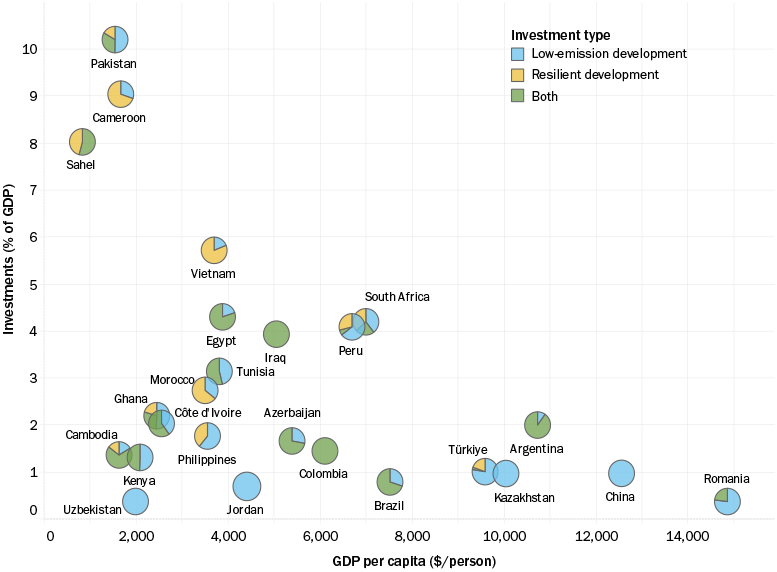You’ve previously explained how CCDR estimates compare with global estimates of climate finance needs, and that considering the differences in ambition, timing, and methodologies, CCDR estimates appear to be consistent with global assessments. Does this still hold?
Broadly yes. There are a number of global estimates by the Independent High-Level Expert Group (IHLEG) on Climate Finance (including a summary of the second IHLEG report), the International Monetary Fund (IMF), and the World Bank’s Beyond the Gap report. But, as we previously noted, these estimates cannot be directly compared with CCDR estimates because they are global, while the sample of CCDR countries is still not representative of global needs, and because they use different scopes, baselines, and mitigation and adaptation scenarios.
However, extrapolating CCDR results using the average investment needs by 2030 per income group yields some interesting results. With this simple approach, and being mindful of the differences in methodologies, we estimate annual climate-related investment needs for all low- and middle-income countries other than China at $574 billion per year (2.8% of GDP) between now and 2030. This is close to IHLEG estimates for 2025 ($600 billion), but significantly lower for 2030 ($1.2-1.7 trillion). It is also lower than IMF and Beyond the Gap estimates ($1.2 and $1.5 trillion by 2030, respectively).
In addition to differences in scopes, baselines and mitigation and adaptation scenarios, is there anything else that can explain these variations?
Yes, a few other important details have emerged.
For instance, we previously explored why adaptation and resilience poses a unique challenge since there are no universally agreed upon quantified objectives as there are for global GHG emissions, and different estimates use different definitions and objectives. The level of investment needed to boost resilience depend on the risk aversion of each community as well as many political and technical factors. A similarly political choice emerges as countries have to consider the retrofitting of existing assets. Multiple CCDRs, such as the Brazil CCDR, as well as our earlier Lifelines report conclude that systematic retrofitting of all existing assets would not be economical and suggests that retrofitting should be limited to the most critical assets. When you include systematic retrofitting, as is done in the Vietnam CCDR, this brings estimates close to that of UNEP’s Adaptation Finance Gap Report or estimates from the IMF, but this may not be desirable from a development and economic perspective.
And, as noted earlier, there are also differences in the ambition of the development scenarios, with a major impact on estimated needs. While all studies use the Sustainable Development Goals (SDGs) as a guide, local priorities and context matter. Some CCDRs use SDGs directly (for instance in Brazil), but most CCDRs use government development objectives and targets to define their development pathway. Depending on the ambition of these objectives, the investment needs can vary widely. For example, the G5 Sahel CCDR identifies investment needs of $71 billion by 2030 (8% of GDP) across the five countries, but because such investment level was unrealistic, even with increased external support, it also provides a less ambitious scenario focusing on the highest-priority investments (amounting to $16 billion by 2030 or 1.8% of GDP). In the Pakistan CCDR, the development scenario includes the provision of universal access to improved water and sanitation by 2030, which increases investment needs compared with less ambitious objectives. In most CCDRs the development scenarios considered do not attempt to achieve all the SDGs, and therefore identified investment needs are lower than in global studies which assume uniform achievement of the SDGs, like IHLEG or the IEA.
What role does the private sector play in all of this?
The second IHLEG report estimates that at least $1 trillion of private capital (of $2.4 trillion total needs) will be needed in low- and middle-income countries other than China by 2030 to meet climate and development goals. CCDRs also explore, country per country and sector per sector, the share of investment needs that could realistically be covered by private investments. But such an assessment is challenging due to lack of data, and it is even more difficult to estimate how the private share could be increased with appropriate policies or financial instruments. That’s because the potential for greater private sector investment does not only depend on the economic enabling environment, but also on the characteristics of each subsector and technologies (for instance, the financing for electric cars and electric buses will be different) and important political choices (such as on the funding and financing models for key services).
Despite this, The expected share of private sector participation varies widely between countries and sectors (figure 2), with much larger potential in industry and energy than in water, for example. This is a promising start to build on―helping to get more private resources to successfully tackle countries’ development and climate investment needs, and freeing up scarce public resources for sectors that still require greater support.



